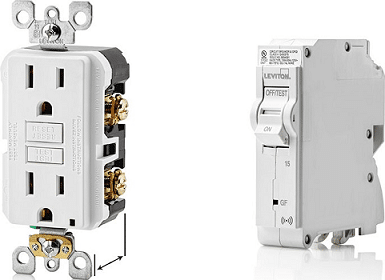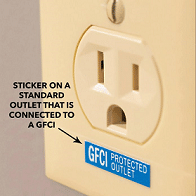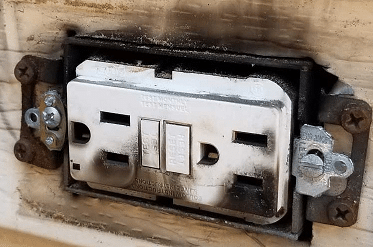GFCI – Ground-Fault Circuit Interrupter Installation
GFCI or ground-fault circuit interrupter installation in your home can be a life-saver!  In order to provide maximum protection, best locations to install ground-fault circuit interrupters are either in the main electrical service panel, or at the first receptacle in the electrical branch circuit. Remember ground-fault protection may be in the form of either a GFCI circuit breaker, or receptacle. Once a properly installed ground-fault device is installed, all remaining downstream receptacles and connected devices are then protected. The National Electric Code (NEC) does require downstream receptacle plates be marked “GFCI protected”, usually with a small blue sticker with white lettering.
In order to provide maximum protection, best locations to install ground-fault circuit interrupters are either in the main electrical service panel, or at the first receptacle in the electrical branch circuit. Remember ground-fault protection may be in the form of either a GFCI circuit breaker, or receptacle. Once a properly installed ground-fault device is installed, all remaining downstream receptacles and connected devices are then protected. The National Electric Code (NEC) does require downstream receptacle plates be marked “GFCI protected”, usually with a small blue sticker with white lettering.
When installing a GFCI outlet, identification of the line versus load terminals are paramount to a successful installation. According to a National Electrical Manufacturers Association (NEMA) survey, miswiring ground-fault circuit interrupters is the single most common cause of device failure or lack of ground-fault protection. To successfully install a GFCI receptacle, power from the electrical service panel must terminate at the line side of the GFCI. All downstream receptacles and other electrical fixtures must be connected to the load side of the GFCI. In the event the GFCI is wired incorrectly, the device, at best, will not provide protection, and at worst, will not function, potentially damaging the onboard electronics. When installing a GFCI circuit breaker, the breaker will connect to the load center busbar. 
GFCI Failures
Research by the National Electrical Manufacturers Association (NEMA) and U.S. Consumer Product Safety Commission (CPSC) found 14 percent of residentially installed GFCI circuit breakers and 8 percent of receptacles did not operate or provide any shock or electrocution protection. More than half of non-operational GFCIs were found to be working after correcting miswiring issues and bringing installations in compliance with manufacturer and NEC requirements. In addition to wiring errors, other significant contributing factors to ground-fault device failure include device age, high humidity, and lightning density. 
Troubleshooting GFCI Protection
Often when an electrical circuit stops working, we check the appliance, and then go to the main electrical panel. What if we find all circuit breakers are on, nothing has tripped? Our first assumption is the appliance must be bad and we need to purchase a new one. Not necessarily, and especially today with supply chain issues, you may wait months for a replacement. The good news is, many times the culprit may in fact be a tripped GFCI receptacle. The challenge is finding the GFCI receptacle, which can be practically hidden. We have found GFCIs in closets, behind other appliances or in completely different rooms or floors of the home. To reset a ground-fault circuit interrupter, first press the reset button, then test, and then reset again. The most common causes of a GFCI not resetting include:
- GFCI wired incorrectly. The number one leading cause to GFCI failures are wiring the power feed from the main electrical service panel into the load side of the GFCI. The NEMA and CPSC research, referenced above, found 56 percent of non-operational GFCIs were caused by violations of NEC wiring guidelines, or failure to install the device in accordance with manufacturer recommendations. Onboard sensors and electronics can detect when a GFCI receptacle is not wired properly and, in many instances, will not allow the GFCI to reset, and in the worst case, may cause internal damage.
- Active ground-fault condition present downstream of the device. Remember, the purpose of a ground-fault circuit interrupter is to disconnect power in the event of a potentially lethal ground-fault. For most ground-fault circuit interrupters the presence of a ground fault on the load side of the device will not only trip the GFCI, but prevent reset until the underlying condition has been resolved. In this case, the GFCI is doing exactly what it was designed to do, protect people.
- No voltage present on the line side of the device. Due to the internal circuitry of GFCI sensors and the onboard printed circuit boards, most GFCIs will not reset without power supplied to the line side of the device. If the electrical branch circuit breaker has not tripped and the device does not have power at the line side, the problem may be a loose connection between the electrical service panel and the ground-fault circuit interrupter, or another upstream GFCI that has tripped.
- Another upstream GFCI tripped. All too often, property owners believe every individual outlet in a bathroom, kitchen or laundry room must be a GFCI type receptacle. This is not necessarily correct. If a single electrical branch circuit has multiple receptacles, only the first receptacle must be a GFCI device, all other downstream standard receptacles will be so protected. This of course does require appropriate NEC compliant labeling of the standard receptacle plate covers to alert an occupant that protection is provided. When multiple GFCI devices are wired in series, in the event of an upstream GFCI tripping, any downstream ground-fault devices will not reset until power has been restored.
- Internal mechanical or electrical failure of the device. Older devices, particularly those in high humidity or high lightning density areas such the Kansas City region, are much more susceptible to failing. Failures may include onboard printed boards, sensors, or mechanical failures from corrosion or UV radiation damage. Best practices for electrical home maintenance are to test GFCI devices regularly. Generally, once per year for high use devices, or GFCIs located in high humid locations such as outdoors or in bathrooms.
Home Performance Group GFCI Installation Kansas City
Concerned about your home’s level of protection? Not sure your ground-fault circuit interrupters are working? Consider hiring a full-service electrical expert with specialized knowledge to properly test, diagnose, and replace GFCI devices. A small upfront investment in careful contractor selection can save both the headache of inconvenience and protect your family.
At Home Performance Group, we continue to invest in technical electrical training. We have performed numerous electrical projects for our clients.
If you are interested in a no-cost in-home consultation, schedule with a Solutions Advisor today.

Article by Larry L. Motley Jr., 14 March 2022
Larry is a graduate of both Wentworth Military Academy and Missouri Western State University earning a double bachelor’s degree in Economics and Finance. Additionally, he maintains six professional tradesman licenses in two states and advanced credentialing in green technology, project and program management, and process improvement. Larry is a three-time combat veteran having served in Operation Iraqi Freedom, Operation New Dawn, and Operation Inherent Resolve. He continues to serve through a value-based building science company focused on providing clients the best design, highest quality installation, and most honest repair services in the community.


Featured Service Areas:
| Missouri | Kansas | ||||
|---|---|---|---|---|---|
|
Belton Blue Springs Cameron Excelsior Springs Gladstone Holt |
Independence Kansas City Kearney Lathrop Lawson Lee's Summit |
Liberty North Kansas City Parkville Platte City Plattsburg Polo |
Raytown Riverside Smithville Sugar Creek Weston |
Kansas City Lansing Leavenworth Leawood Lenexa |
Merriam Mission Mission Hills Praire Village Shawnee |






















